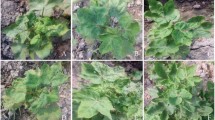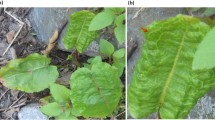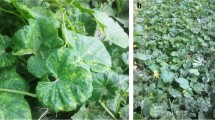Abstract
Betasatellites are symptom-modulating DNA satellites that are associated with the majority of monopartite begomoviruses in the Old World. Betasatellites show both geographical and host-specific relatedness; those isolated from malvaceous hosts form one group and those isolated from non-malvaceous hosts form the second group. Real-time PCR based estimation of begomovirus DNA in cotton species grown in a living herbarium under field conditions at the Central Cotton Research Institute (CCRI), Multan was carried out to understand their role in the ongoing cotton leaf curl disease (CLCuD) epidemic in Pakistan. The levels of begomovirus DNA in cotton species from the herbarium was found to be several folds lower than symptomatic plants of commercially grown cotton. Among herbarium species Gossypium anomalum, G. robinsoni and G. somalense contained higher levels of begomovirus DNA in comparison to other wild species. Characterization of betasatellites from two cotton species (G. anomalum and G. somalense) was carried out to understand their role in accumulation of begomovirus DNA. Here, we show that the two wild species of cotton are associated with Cotton leaf Multan betasatellite (CLCuMB), a malvaceous betasatellite associated with CLCuD, as well as Chili leaf curl betasatellite, a non-malvaceous betasatellite not previously identified in a malvaceous host. This is the first evidence of the presence of a non-malvaceous betasatellite in malvaceous hosts.



Similar content being viewed by others
References
I. Amin, S. Mansoor, L. Amrao, M. Hussain, S. Irum, Y. Zafar, S.E. Bull, R.W. Briddon, Arch. Virol. 151, 2055–2065 (2006)
L. Amrao, I. Amin, M.S. Shahid, R.W. Briddon, S. Mansoor, Virus Res. 152, 153–163 (2010)
R.W. Briddon, S.E. Bull, I. Amin, A.M. Idris, S. Mansoor, I.D. Bedford, P. Dhawan, N. Rishi, S.S. Siwatch, A.M. Abdel-Salam, J.K. Brown, Y. Zafar, P.G. Markham, Virology 312, 106–121 (2003)
R.W. Briddon, S. Mansoor, I.D. Bedford, M.S. Pinner, P.G. Markham, Virus Genes 20, 17–24 (2000)
R.W. Briddon, S. Mansoor, I.D. Bedford, M.S. Pinner, K. Saunders, J. Stanley, Y. Zafar, K.A. Malik, P.G. Markham, Virology 285, 234–243 (2001)
R.W. Briddon, J. Stanley, Virology 344, 198–210 (2006)
M.S. Brown, Y.M. Margaret, J. Hered. 41, 291–292 (1950)
S. Das, A. Roy, R. Ghosh, S. Paul, S. Acharyya, S.K. Ghosh, Virus Genes 37, 414–424 (2008)
E. Domingo, E. Baranowski, C.M. Ruiz-Jarabo, A.M. Martin-Hernandez, J.C. Saiz, C. Escarmis, Emerg. Infect. Dis. 4, 521–527 (1998)
J.J. Doyle, J.L. Doyle, Focus 12, 13–15 (1990)
Fryxell P.A., Texas A & M University Press: College Station and London (1979)
C. Ha, S. Coombs, P. Revill, R. Harding, M. Vu, J.J. Dale, J. Gen. Virol. 89, 312–326 (2008)
B.D. Harrison, Y.L. Liu, S. Khalid, S. Hameed, G.W. Otim-Nape, D.J. Robinson, Ann. Appl. Biol. 130, 61–75 (1997)
M. Hussain, S. Irum, S. Mansoor, R.W. Briddon, J. Phytopathol. 157, 576–579 (2009)
A.M. Idris, R.W. Briddon, S.E. Bull, J.K. Brown, Virus Res. 109, 19–32 (2005)
S. Mansoor, R.W. Briddon, S.E. Bull, I.D. Bedford, A. Bashir, M. Hussain, M. Saeed, Y. Zafar, K.A. Malik, C. Fauquet, P.G. Markham, Arch. Virol. 148, 1969–1986 (2003)
S.S. Naranyanan, P. Singh, Indian Soc. Cotton Improv. J. 19, 10–24 (1994)
R.D.M. Page, Comput. Appl. Biosci. 12, 357–358 (1996)
J. Qazi, I. Amin, S. Mansoor, J. Iqbal, R.W. Briddon, Virus Res. 128, 135–139 (2007)
W.L. Rooney, D.M. Stelly, D.W. Altman, Crop Sci. 31, 337–341 (1991)
M. Saeed, S.A.A. Behjatnia, S. Mansoor, Y. Zafar, S. Hasnain, M.A. Rezaian, Mol. Plant Microbe Interact. 18, 7–14 (2005)
P. Sharma, N. Rishi, V.G. Malathi, Virus Genes 30, 85–91 (2005)
J.D. Thompson, T.J. Gibson, F. Plewniak, F. Jeanmougin, D.G. Higgins, Nucleic Acids Res. 25, 4876–4882 (1997)
C.P. Yik, W.J. Birchfield, J. Nemato. 16, 146–153 (1984)
Acknowledgments
MTA was supported by by a Ph.D Studentship from the Higher Education Commission (HEC), Pakistan. RWB was supported by the HEC under the ‘Foreign Faculty Hiring Scheme’. This research work was carried out under Pak-USA linkage project between NIBGE (SM) and Donald Danforth Plant Science Center, St. Louis, USA (PI Dr. Claude M Fauquet).
Author information
Authors and Affiliations
Corresponding author
Electronic supplementary material
Below is the link to the electronic supplementary material.

11262_2010_521_MOESM1_ESM.jpg
Real time PCR data. (A) Amplification chart of the cultivated and wild species of genus Gossypium. (B) Standard curve for the absolute quantification and (C) melt curve data indicative of amplification of a single product. The efficiency of the PCR was 98.2%. All amplifications were repeated three times. (JPEG 298 kb)
Rights and permissions
About this article
Cite this article
Azhar, M.T., Amin, I., Anjum, Z.I. et al. Both malvaceous and non-malvaceous betasatellites are associated with two wild cotton species grown under field conditions in Pakistan. Virus Genes 41, 417–424 (2010). https://doi.org/10.1007/s11262-010-0521-4
Received:
Accepted:
Published:
Issue Date:
DOI: https://doi.org/10.1007/s11262-010-0521-4




